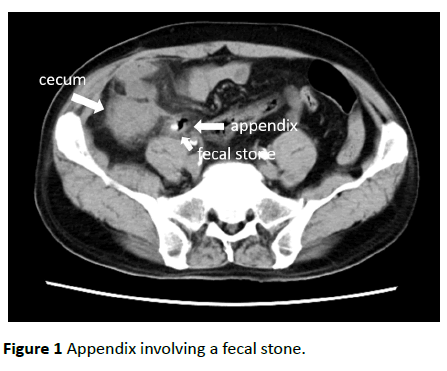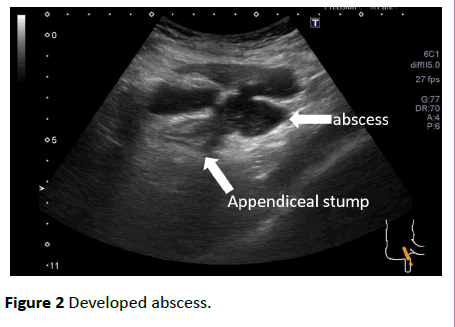Masaaki Ito1, Kouji Yasumoto2 and Katsuya Shiraki3*
1Department of Internal Medicine, Mie General Medical Center, Hinaga, Yokkaichi, Japan
2Department of Radiology, Mie General Medical Center, Hinaga, Yokkaichi, Japan
3Department of Gastroenterology, Mie General Medical Center, Hinaga, Yokkaichi, Japan
*Corresponding Author:
Katsuya Shiraki
Department of Gastroenterology, Mie General Medical Center, Hinaga, Yokkaichi, Japan
Tel: +81-59-345-2321
E-mail: katsuya-shiraki@mie-gmc.jp
Received date: January 19, 2018; Accepted date: January 22, 2018; Published date: January 24, 2018
Citation: Ito M, Yasumoto K, Shiraki K (2018) Stump Appendicitis. J Clin Gastroenterol Hepatol Vol.2: No.1:2. doi:10.21767/2575-7733.100031
The patient was a 72-year-old man referred to our hospital because of a two-day history of acute right lower abdominal pain. He had undergone an open appendectomy 13 years previously. Laboratory testing revealed a white blood cell count of 4440 cells/mm3 and C-reactive protein of 0.025 mg/dL.
Abdominal CT suggested swelling of the appendix involving a fecal stone with surrounding inflammation, which indicated an abscess around the appendix (Figure 1). Ultrasonography clearly demonstrated the appendix remnant with a length of 40 mm and diameter of 15 mm, which had perforated into the abdominal cavity and developed an abscess (Figure 2). According to these findings, the diagnosis of stump appendicitis was made. Open appendectomy and ileocecolostomy were performed.

Figure 1: Appendix involving a fecal stone.

Figure 2: Developed abscess.
Stump appendicitis is thought to be increasing in patients who undergo laparoscopic appendectomy [1,2]. Clinicians must be aware that stump appendicitis should be considered in patients with right lower quadrant pain after prior appendectomy.
References
- Kanona H, Al-Samaraee A, Nice C, Bhattacharya V (2012) Stump appendicitis: A review. Int J Surg 10: 425-428.
- Awe JA, Soliman AM, Gourdie RW (2013) Stump appendicitis: An uncompleted surgery, a rare but important entity with potential problems. Case Rep Surg 2013: 972596.



